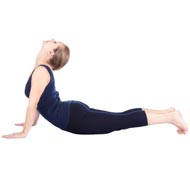- Aromatherapy (36)
- Benefits of Yoga (282)
- Home Remedies (1087)
- massage therapy (9)
- Preventive Therapy (135)
- Running (41)
- Skin Care (15)
- Stress Relief (25)
- Stretching (5)
- walking (33)
- Womens Health (14)
- Yoga Benefits for Pregnant Women (16)
- Yoga Benefits for Students (3)
- Yoga for Children (11)
- Yoga for Holistic Living (37)
- Yoga for Midlife Crisis (3)
- Yoga for Senior Citizens (2)
- Yoga for the Workplace (1)
- Yoga Health Tips (185)
- Yoga Practice during Menstruation (5)
Practicing Basic Yoga Poses and Exercises for Disease Free Health

In the absence of specific information such as your age, gender and presence of any health condition, it becomes rather difficult to give precise suggestions and recommendations. However, given below is some basic information on Yoga for stable health. Yoga is an age old, holistic science and art of living that caters to the body, mind, emotions and spirit. The father of this great practical system of learning is the sage Patanjali, whose life and background, to this day, remain mysterious. Yoga is also called Ashtanga Yoga because it consists of the following eight limbs
- Yamas (Observances or Do’s)
- Niyamas (Restraints or Don’ts)
- Asana (Yoga postures)
- Pranayama (Breathing exercises)
- Pratyahara (Withdrawal of the senses)
- Dharana (Concentration)
- Dhyana (Meditation)
- Samadhi (A state of super consciousness)
Exercises and asanas (poses) form a very small part of Yoga. According to this philosophy, stable health is not confined to the body alone. Rather, the body is just a manifestation of one’s spiritual, emotional and mental health. The world, today, is largely beset, by what are called, ‘psychosomatic ailments’. Almost all of these, such as High and Low Blood Pressure, Cardiovascular Disease, Asthma, Sinusitis, Chronic Constipation and Ulcerative Colitis, have their roots in the mind and emotions.
Yoga, through a set of practices that include asanas (poses), pranayamas (breathing exercises) kriyas (cleansing techniques), together with a Yoga diet and meditation, help cleanse and heal you at the physical, mental, emotional and spiritual levels. Then, and only then, does stable health come about. The asanas (poses) are many and are done in the following positions:
- Standing
- Seated
- Supine
- Prone
- Inverted, and
- Balancing
The pranayamas (breathing exercises) are
- Anuloma-Viloma (Alternate Nostril Breathing)
- Ujjayi (Ocean Breath)
- Brahmari (Bee-buzzing Breath)
- Bhastrika (Bellows Breath)
- Sitali (Cooling Breath)
- Sitkari (Hissing Cooling Breathing Technique)
- Suryabhedana (predominantly Right Nostril Breathing)
All pranayamas (breathing exercises) should, necessarily, be preceded by a cleansing kriya named Kapalabhatti (Skull Cleansing).
The kriyas (cleansing techniques) are
- Kapalabhatti (Skull Cleansing)
- Vaman Dhauti (Abdominal Cleansing by vomiting saline water)
- Jala Neti (Cleansing nasal passages with saline water)
- Sutra Neti (Cleansing nasal passages with a rubber catheter)
- Nauli (Stomach Churning)
- Basti (Rectal Enema)
- Shanka Prakshalanam (Oral Enema)
- Trataka (Fixed gazing to generate tears)
Finally, if you wish to attain stable health, you will have to adhere to a Yogic diet. In yogic parlance this is called a Sattvic (pure, light and predominantly vegetarian) diet. It is rich in fresh fruits and nuts, salads, vegetables, preferably green leafy vegetables, plenty of yoghurt and buttermilk, whole grain brown bread and brown rice. Go easy on non-veg fare (if you can’t give up completely). And do avoid all stale, spicy, deep fried, fast / junk foods plus aerated and caffeinated beverages. Also, please steer clear of tobacco and alcohol. To learn the Yoga practices appropriate for you, you had best enroll into the nearest Yoga institute in your vicinity.
- RSS Feeds -
- All posts
- All comments
- Are you ready to take it to the next level? A regular yoga practice can be a powerful tool in bringing health and wellbeing ...
- Fitness Equipment Yoga Yoga aims to harmonize your mind and body with great physical and mental work...
- Yoga Lesson Planning Different schools of yoga teach different exercises and routines that are aim...
- Practice Sudarshan Kriya To Have A Heart Healthy Yoga and meditation has long since been used to treat health conditions, rang...